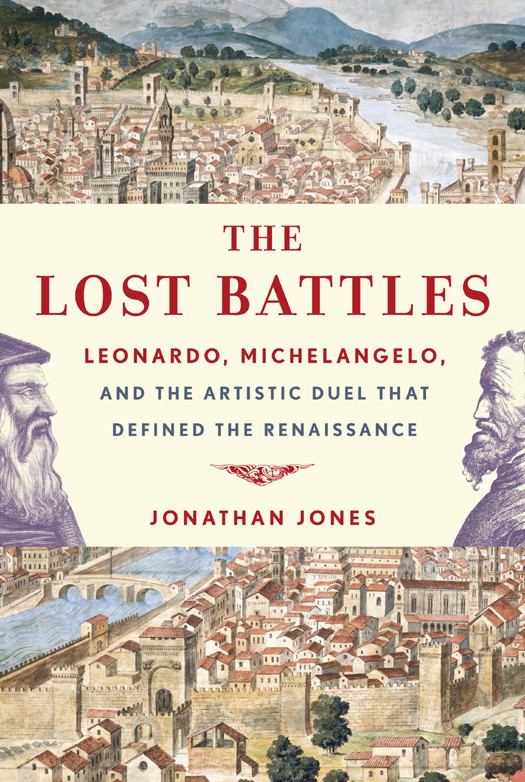
The Lost Battles
Leonardo, Michelangelo, and the Artistic Duel That Defined the Renaissance
کتاب های مرتبط
- اطلاعات
- نقد و بررسی
- دیدگاه کاربران
نقد و بررسی

August 13, 2012
In 1503, Leonardo da Vinci, already famous for his towering genius, groundbreaking drawings of human anatomy, and scientific achievements, was commissioned to paint a mural in Florence’s Great Council Hall memorializing the Battle of Anghiari. As Leonardo was planning the contours of his painting, a young and less well-known sculptor and artist, Michelangelo, was commissioned to paint a mural of another battle famous in Florentine history, the Battle of Cascina, in the same room. As art critic Jones points out in this energetic, fast-paced, though sometimes repetitive, tale of rivalry and genius, this event became a competition to discover which of the two was “the greatest artist in the world.” Leonardo’s painting depicts the reality of war in all its horror and grows out of his own experience witnessing military battles. Michelangelo had never been in combat or seen its aftermath, and his scenes of combat are more cerebral. While Michelangelo’s The Battle of Cascina gravely and compassionately depicts the humanity of war, Leonardo’s The Battle of Anghiari portrays the horrifying images of the battle’s madness. Jones’s dazzling study of this little discussed competition illustrates the ways that these two great artists competed to assert their imaginations and personalities, giving birth to the Renaissance idea of the artist as godlike creator rather than mere artisan reshaping existing materials. Agent: Janklow & Nesbit.

Starred review from September 1, 2012
Guardian art critic Jones rejoices in revealing the talents of Leonardo da Vinci and Michelangelo and the challenge of deciding who was the true master. Competition was fundamental to the culture of brilliance in Renaissance Florence, driving creativity and innovation. The contest between Ghiberti and Brunelleschi to create the bronze doors of the Baptistery is a case in point; the author firmly states that the committee was correct in its choice of Ghiberti, leaving Brunelleschi to his dome. There is a wealth of information about da Vinci and Michelangelo, and Jones skillfully harvests the best, amusing with his delightful asides and enlightening with his erudite opinions. As Giorgio Vasari declared, da Vinci was the first great artist of the period who defined nature, perspective and technical mastery, while Michelangelo was its ultimate genius. The story focuses on two commissions to decorate the Great Council Hall of the Palazzo Vecchio, with each artist painting an opposite wall. Jones deftly analyzes their talents and personalities. The preening da Vinci launched theories and works of art but seemed only to enjoy the journey, as he often failed to complete his works. His interests constantly distracted him from his tasks. Michelangelo, on the other hand, was an emotional, fiery poet constantly seeking a cause for his anger. While da Vinci was a master of dissection and produced brilliant drawings, Michelangelo presented the human body as an idyllic landscape. Even as they appeared to be at odds, each often used ideas from the other, like Leonardo's bastions of Piombino, which Michelangelo copied for Florence. Art lovers, Renaissance junkies and even travelers will love this book, which brings these two geniuses to vivid life and teaches how easy it is to love art.
COPYRIGHT(2012) Kirkus Reviews, ALL RIGHTS RESERVED.

October 1, 2012
Jones (art critic, Guardian) recounts the rivalry and competition between the two great Renaissance artists, Leonardo da Vinci and Michelangelo Buonarroti. The conflict began when Michelangelo, the younger of the two by 23 years, approached Leonardo on a Florence street and insulted the more mature artist, criticizing what he perceived as Leonardo's lack of technical skill in casting in bronze, specifically in reference to a design for a giant horse sculpture that Leonardo planned but never executed. In turn, Leonardo sketched a parody of Michelangelo's famous sculpture David and went further, condemning it for indecency to the extent that, when it was placed on public display, it was strategically covered with a brass thong ornamented with copper leaves. Thus, Jones's book is a portrait of two geniuses continually trying to outdo each other through their creative prowess and individual artistic visions. VERDICT Although this is a scholarly work complete with footnotes and a bibliography, Jones's writing style is somewhat informal with an emphasis on narrative, so this is recommended for students of art history as well as the general reader interested in these two Renaissance masters.--Sandra Rothenberg, Framingham State Univ., MA
Copyright 2012 Library Journal, LLC Used with permission.

September 1, 2012
Simultaneously in 1503, in the Palazzo Vecchio in Florence, Leonardo was commissioned to paint The Battle of Anghiari and Michelangelo The Battle of Cascina. Despite the hyped-up subtitle, there was no duel, and their rivalry did not define the Renaissance. Nor was it, as Jones claims in hothouse prose, the savage and merciless collision of titanic egos . . . in all its agony and ecstasy. Taking up the theme first stated by the artists' contemporary biographer Giorgio Vasari and continued in Rona Goffen's Renaissance Rivals (2002), this familiar material is served up in a new way. Unfortunately, several of Jones' assertions are dubious. Leonardo's horses bit but did not cannibalize each other (horses don't eat meat). Jones describes Michelangelo's painting as both No battle. No fighting. Just men getting out of the water, naked and as alert, courageous, active soldiers rushing to seek the enemy. Despite these flaws, Jones is incisive about Leonardo's Notebooks as well as learned, lively, and challenging. Ironically, the whole book concerns paintings that were scarcely begun and whose huge preliminary drawings have completely disappeared.(Reprinted with permission of Booklist, copyright 2012, American Library Association.)

























دیدگاه کاربران